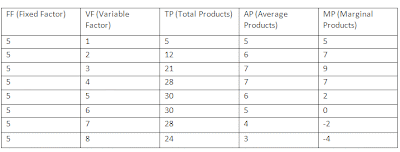“Explain the Law of Variable Proportion.” The question has been solved for MB0042 (Managerial Economics) SMU MBA assignment. I have already submitted the solved assignments for MB0042 - Elasticity of Demand, Price Discrimination and Marginal Efficiency of Capital.
Law of Variable Proportion:
Total Product (TP) – Total quality of output produced by a firm.
Average Product (AP) – The total produced by a firm divided by the quantity of variable factors used to produce.
AP = TP/Q
AP – Average Product
TP – Total Product
Q – Number of Variable Factors
Marginal Product (MP) – Change in TP caused as a result of additional unit of Variable factor employed to the combination of Fixed Factor.
Law of variable proportion is also called Law of Diminishing Returns. It examines the production function when one factor varies keeping the quantities of other fixed factors constant. That is how the output varies when Variable Factors are employed to the fixed factors.
The law states, when Variable factors are increased in equal doses keeping the Fixed Factor constant, the total product will increase. But after a certain point it will increase at a diminishing rate and finally the total product starts decreasing.
Assumption:
This law is subject to certain assumptions:
1. The state of technology is given
2. Only one factor of production must be variable. In the example illustrated below, we have taken it as labour
3. There are some inputs, which are kept constant of fixed

In the above table, first column shows fixed factor as the land, say 5 acres. Second column shows labour as variable factor. Third column shows Total Product which changes due to change in the variable factor. Fourth column shows AP which is derived by dividing TP with Q. Fifth column, is MP which is derived by change in TP with change in Q. In the above table, at the fourth unit of variable factor, the total product reaches maximum and then starts has reached its maximum at third unit of variable factor. Marginal product starts falling first, average product follows it and total product falls last.
Law of Variable Proportion:
Total Product (TP) – Total quality of output produced by a firm.
Average Product (AP) – The total produced by a firm divided by the quantity of variable factors used to produce.
AP = TP/Q
AP – Average Product
TP – Total Product
Q – Number of Variable Factors
Marginal Product (MP) – Change in TP caused as a result of additional unit of Variable factor employed to the combination of Fixed Factor.
Law of variable proportion is also called Law of Diminishing Returns. It examines the production function when one factor varies keeping the quantities of other fixed factors constant. That is how the output varies when Variable Factors are employed to the fixed factors.
The law states, when Variable factors are increased in equal doses keeping the Fixed Factor constant, the total product will increase. But after a certain point it will increase at a diminishing rate and finally the total product starts decreasing.
Assumption:
This law is subject to certain assumptions:
1. The state of technology is given
2. Only one factor of production must be variable. In the example illustrated below, we have taken it as labour
3. There are some inputs, which are kept constant of fixed

In the above table, first column shows fixed factor as the land, say 5 acres. Second column shows labour as variable factor. Third column shows Total Product which changes due to change in the variable factor. Fourth column shows AP which is derived by dividing TP with Q. Fifth column, is MP which is derived by change in TP with change in Q. In the above table, at the fourth unit of variable factor, the total product reaches maximum and then starts has reached its maximum at third unit of variable factor. Marginal product starts falling first, average product follows it and total product falls last.
